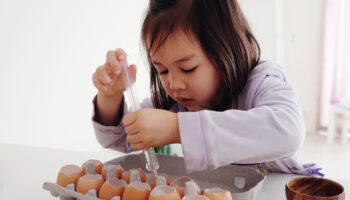Kelli Harris
What exactly is Earth Day? The first Earth Day occurred in 1970, after a U.S. Senator saw the impact of an oil spill in California. Earth Day is celebrated each year on April 22nd and this year marks the 50th Anniversary. It is about raising awareness of the importance of protecting our planet and taking action to do so, focusing on promoting clean living and healthy habitats for people and animals. Each year, more than a billion people observe Earth Day.
Here are some ways that you can incorporate some Earth Day ideas/activities into your classroom. Some easy ideas:
- Teach children to flip paper over and use the back side. Make a bin for scraps, rather than using a new piece of paper to cut up for art project. Put out small amounts of a variety of collage items at a time for children to use, but refill often.
- Get parents involved. How do they make an impact at home? Do they use reusable tote bags for shopping, buy some of their clothes at thrift stores, volunteer at the local food bank? Ask for parents to come in and talk about their experiences.
- Ask colleagues and parents to donate recyclables (paper tubes, egg cartons, fabric scraps, soda bottles, food boxes, magazines, etc.) Some programs I’ve assessed get milk cartons delivered for lunch–rinse those out and think about how they can be re-used. As a director, I once had a parent bring in an entire bag of old film canisters (remember those?) and children used them to make homemade shakers for music. Another parent worked for an envelope company and when they discontinued certain items, she would bring them into us. Children would write “notes” to their friends or their parents and tuck them in to the envelopes. Another parent was a manager at a paint and wallpaper store and would bring us wallpaper books and paint chip samples for our art center. Do you have a spouse like mine who loves to order from Amazon? Think about how you could re-use those boxes. Maybe make a mailbox from those recycled boxes and you’ve helped start a new theme in your dramatic play area! Or you can reuse those Amazon boxes to donate unwanted items at GiveBackBox.
- Spring Cleaning happens for many people around the same time as Earth Day is celebrated. Ask for donations of clothing and household items to change up your dramatic play area. I once assessed a program that incorporated clothing into their lesson plan. Children designed their own clothing from fabric scraps, created a washer and dryer from donated boxes to create a laundromat in the dramatic play area, matched buttons to pattern cards, and did a science experiment with detergent and dyes to incorporate science. The possibilities are endless.
- Make it fun and be creative! Have a recycling contest in your program. A program I recently assessed has a contest among all of the after-school locations. Winners for largest structure, use of most materials, etc.
- The Environment Rating Scales have incorporated items in the Activities subscale-Science area to reflect ways to help the environment. Both the ITERS at indicator 7.2 and the FCCERS at indicator 7.1–Staff show interest in and respect for nature. Could you show the young children how to handle natural items and pets carefully? The ECERS-R has incorporated an indicator at 5.4–Everyday events used as a basis for learning about nature/science. Can you read books about endangered species or observe birds/animals when outside on the playground? The ECERS-3 has incorporated an indicator at 5.3–Staff model concern for the environment. Can you remind children to turn off the lights when you leave the room or remind the children to recycling items? The SACERS-U at indicator 7.1–Staff introduce new concepts and provide activities to help children realize how science informs their daily lives. Can you discuss climate change or practice conservation of water when washing hands or brushing teeth?
- Some topics related to Earth Day may be too difficult for children to understand–toxic dumps, sewage, but some can be made very relatable to children–recycling, wildlife extinction, pollution. The purpose of Earth Day is not to focus on our planet for one day, but continue to make an impact on the environment throughout our lives. What changes can you make regularly with the children? Put a recycle bin in your classroom, plant a tree or seed in a garden on your property, walk around the neighborhood and count how many pieces of trash you find. Can children bring in reusable water bottles/sippy cups rather than using and throwing away plastic cups each day? Teaching children that the small things that matter can make a significance on not only the environment, but the children as well. Check out the websites below for more ideas and inspiration!
8 Interactive Ways to Teach Children about Earth Day
6 Earth Day Activities for Toddlers and Preschoolers
29 Ideas, Big and Small, to Bring Recycling Into the Classroom




